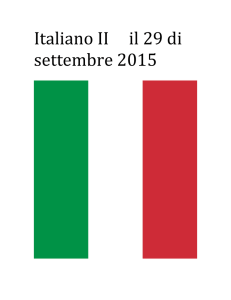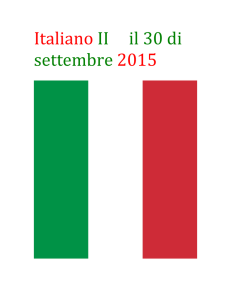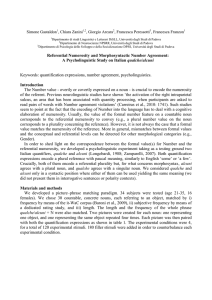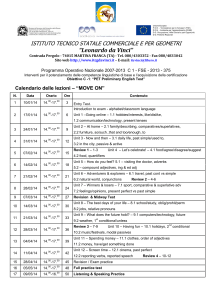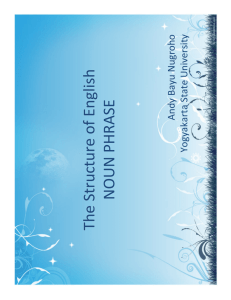il 22 di Settembre
advertisement
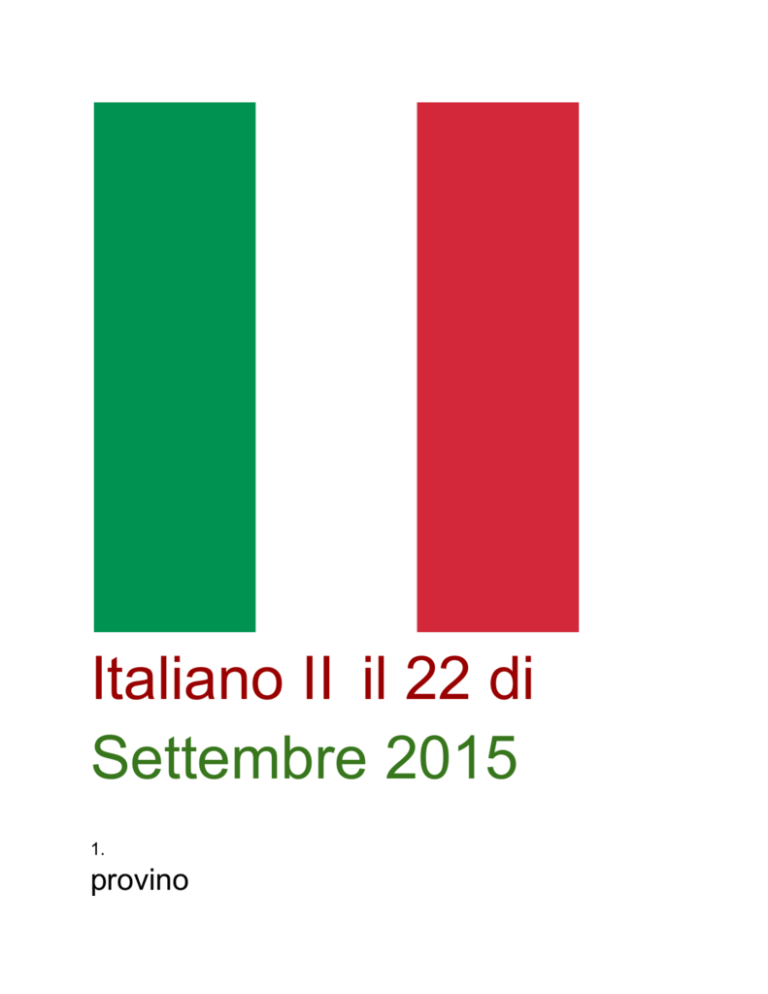
Italiano II il 22 di Settembre 2015 1. provino 1. Pulire 2. mettere 3. pagare 4. giocare 5. pensare 6. ubbidire but for block III - Spedire 7. soffrire 8. riferire 9. restituire 10. cercare Bonus 1. The classroom= 2. Hotel= 3. Subjects= La Lezione L’ introduzione alla la lezione I 1. Attivita’ alla lavagna 2. Ripasso I verbi -are -ere -ire Oggi in Italia 3. Ripassi di QUESTION WORDS: Italian question words It may be a little late in the game for discussing these, but it's still worth covering the topic of question words in Italian and looking at some ways they might be used which aren't immediately apparent. Che? The word che in Italian means what, but when asking "what" questions it is preferred to ask che cosa, or "what thing". In fact, this is so common that it is actually possible to omit che and just ask cosa as if it were a question! Che cosa fai? What are you doing? Cosa hai detto? What did you say? Chi? The word chi means who. It can be used to ask and answer question about people. Chi hai incontrato? Who did you meet? chi riceve gli ospiti host (the one who receives guests) Dove? The word dove is used to ask where questions. Also, one interesting thing to note is that for questions of "how far?", Italians ask fin dove? or "ending where?". Di dove sei? Where are you from? Fin dove andrai? How far will you go? Quando? The Italian word quando means when. It asks and answers "when" questions. When paired with da (from), it can be used to form the present perfect tense. Quando torni? When will you return? Da quando sei qui? How long have you been here? Perché? The word perchè means both why and because. Sono in ritardo perché avevo dimenticato di mettere la sveglia. I an late because I forgot to set my alarm clock. Dimme perchè. Tell me why. Come? The word come means both how and like. It is capable of both asking and answering "how" questions. Come è vestido? How is he dressed? È vestido come un poliziotto. He is dressed like a policeman. It can also be used in the phrase come mai to ask "why" questions (how come). Come mai non sei venuto alla festa? Why didn't you come to the party? Quanto? The Italian word quanto translates both as how much and how many, depending on its ending. In English, we have separate words for questions about single or plural quantities. In Italian, you just pluralize the question word as you would any other word. Quanto sono grandi i cani? How big are the dogs? Quanto anni hai? How old are you? Quale? The word quale is the equivalent of the English question word "which". Quale preferisci? Which one do you prefer? Quale macchina è la tua? Which car is yours? 4. Vocabolario delle presentazioni. Introducing yourself First impressions are important — they can start a friendship or set the tone for your interaction with someone. Start with a greeting. 1. The simplest greeting is Ciao or Buon giorno, which means Hello or Good Day. 2. Introduce yourself The two most common ways to introduce are to say Mi chiamo Name (My name is Name) or Sono Name (I'm Name).Since you are meeting the person for the first time, you should use the more formal form of you 3. Use the formal Lei (singular you) when speaking to people you don't know well; in situations such as in stores, restaurants, hotels, or pharmacies); and with professors, older people, and your friends' parents. Save the informal tu (singular you) and voi (plural you) for friends, relatives, younger people, and people you know well. 4. The formal Loro (plural you) is rarely used and is gradually being replaced by the informal voi when addressing a group of people: 5. Come ti/si chiami? (What's your name? [Informal]) 6. Lei come si chiama? (What's your name? [Formal]) 7. After they tell you their name you should express pleasure. For example. 8. Piacere! (Nice to meet you!) 9. Piacere di conoscerla (Pleased to meet you.) Asking "Where are you from?" You don't need to stop at introductions; you could also take this opportunity to talk about where each of you is from. To tell them where you're from, say Sono degli Stati Uniti. (I'm from the United States.) To ask where the person is from, you can say: ● Di dove sei? (Where are you from? [Informal]) ● Di dov'è Lei? (Where are you from? [Formal]) If you want to talk about where you live on the other hand, you can use the verbs abita or vivere — both of which mean to live: ● In quale città abita? (What city do you live in?) ● Lei abita qui? (Do you live here?) ● Dove vive? (Where do you live?) ● Vivo a Los Angeles. (I live in Los Angeles.) Introducing other people The second most common type of introduction is to introduce someone else, such as your spouse, child, or friend. The following phrases are typical of introducing someone else. ● Permette che mi presenti mia moglie? (May I introduce my wife?) ● Permette che mi presenti mio fidanzato, Antonio? (May I introduce my fiancé, Antonio?) ● Le/ti presento un amico mi, James. (This is my friend, James. [F/M]) Put the steps together and see how it comes together in a conversation. Larry: Buongiorno. Mi chiamo Larry. Lei come si chiama? (Hello. My name is Larry. What's your name?) Maria: Sono Maria. (I'm Maria.) Larry: Piacere di conoscerla. (It's a pleasure to meet you.) Maria: E lei. (And you.) Larry: Lei abitaqui? (Do you live here?) Maria: Sì. Di dov'è Lei? (Yes. Where are you from?) Larry: Sono degli Stati Unit. Vivo a Los Angeles. (I'm from the United States. I live in Los Angeles.) Maria: Permette che mi presenti mio fidanzato, Antonio? (May I introduce my fiancé, Antonio?) Larry: Piacere! (Nice to meet you!) Nouns and articles in Italian . Definite Articles Here are the Italian definite articles. Notice that there are different forms based on gender, number, and the beginning letter of the noun. Remember that articles are used to specify the application of a noun. The forms of the definite article in Italian lo - used before masculine nouns (in the singular form) beginning with "z" or with "s" + a consonant l'- used before masculine nouns (in the singular form) beginning with any vowel gli - used as the plural form for the above 2 examples il - used before masculine nouns (in the singular form) beginning with any other consonant i- used as the plural form for "il" la - used before feminine nouns (in the singular form) beginning with any consonant l'- used before feminine nouns (in the singular form) beginning with any vowel le - used as the plural form for all feminine nouns Examples: l'amico (the [male] friend) becomes gli amici (the [male] friends) l'amica (the [female] friend) becomes le amiche (the [female] friends) Indefinite Articles Here are the Italian indefinite articles. Notice that there are different forms based on gender, number, and the beginning letter of the noun. The forms of the indefinite article in Italian uno - used before masculine nouns (in the singular form) beginning with "z" or with "s" + a consonant un - used before masculine nouns (in the singular form) beginning with a vowel or any other consonant una - used before feminine nouns (in the singular form) beginning with any consonant un' - used before feminine nouns (in the singular form) beginning with any vowel Gender of Nouns In Italian, nouns have grammatical gender and are either masculine or feminine. For the most part, you can tell the gender of a noun in Italian by looking at the ending. A noun ending in "o" is usually masculine and a noun ending in "a" is usually feminine. When a noun ends in "e" (which is a common ending), you will have to memorize the gender when you memorize the word. Here is a list of endings that usually correspond to either the masculine or the feminine, however there are a few exceptions. Masculine Endings in Italian Feminine Endings in Italian è - il caffè, etc. ì - il tassì, etc. ò - il comò, etc. amma - il programma, etc. ema - il problema, etc. ore - il colore, etc. Alla Facolta’ Vocabolario Italian Vocabulary à - la città, etc. ù - la virtù, etc. ione - la televisione, etc. si - la crisi, etc. . I OGGETTI IN UN'AULA Italiano English l'aula f classroom il blocchetto per appunti notepad la borsa bag il cancellino board eraser la carta paper la cartella folder la classe class l'evidenziatore m highlighter pen un foglio di carta a sheet of paper il gessetto piece of chalk la gomma eraser (US), rubber (GB) la lavagna blackboard la lavagna bianca whiteboard il lettore di cassette tape player il libro book il libro di esercizi workbook la matita pencil il pastello crayon il pennarello board pen, felt-tip pen la perforatrice hole punch il portafogli briefcase il registratore tape recorder il righello ruler la scrivania desk la scuola school la sedia chair il taccuino notebook il temperamatite, il temperino pencil sharpener alzare la mano to raise one's hand aprire/chiudere il libro to open/close the book ascoltare una cassetta to listen to a tape cancellare la lavagna to clean the board condividere il libro to share a book fare una domanda to ask a question guardare un video to watch a video lavorare a coppie to work in pairs lavorare a gruppi to work in groups parlare col tuo compagno to talk to your partner scambiare i posti to swap places The classroom SCHOOL LIFE lesson La lezione pupil L'allievo boarder Il convittore bell La campanella homework Il compito timetable L'orario term/semeste r Il periodo / quadrimestre detention Il penso study period Il periodo di studi STATIONERY Biro La penna a sfera fountain pen La penna stilografica pencil La matita eraser STATIONERY Biro La penna a sfera fountain pen La penna stilografica pencil La matita eraser La gomma chalk Il gessetto blackboard La lavagna paper La carta sheet of paper Il foglio di carta- book Il libro text book Il libro di testo exercise book Il quaderno rough book Il quaderno di brutta note book Il notes calculator La calcolatrice ADJECTIVES Italian and English differ in their usage of adjectives. Italian descriptive adjectives are usually placed after the noun they modify, and with which they agree in gender and number. COMMON ITALIAN ADJECTIVES ENDING IN -O allegro cheerful, happy buono good, kind cattivo bad, wicked freddo cold grasso fat leggero light nuovo new pieno full stretto narrow timido timid, shy Adjectives ending in -o have four forms: masculine singular, masculine plural, feminine singular, and feminine plural. Observe how the adjectives nero and cattivo change to agree with nouns they modify. ENDINGS OF -O ADJECTIVES SINGULAR PLURAL il gatto nero (the black cat, masculine) i gatti neri (the black cats, masculine) la gatta nera (the black cat, feminine) le gatte nere (the black cats, feminine) il ragazzo cattivo (the bad boy) i ragazzi cattivi (the bad boys) la ragazza cattiva (the bad girl) le ragazze cattive (the bad girls) Note that when an adjective modifies two nouns of different gender, it retains its masculine ending. For example: i padri e le madre italiani (Italian fathers and mothers). Adjective agreement review . Essential Italian Grammar – Adjectives The adjective is a variable part of the speech, which is added to a noun in order to give it a quality or to define it in a better way. Adjectives give sentences meaning, color and excitement. Without them, it would be difficult to visualize the people, places and things that are described in a given narrative. Imagine reading a story with no descriptions of the characters, such as their physical attributes or their emotional state. It would be a pretty boring story, wouldn't it? Adjectives in English appear before a noun. Now, let's take a look at adjectives in Italian: According to the linked noun, the adjective can have: ● an attributive function, when it is linked directly to a noun. Il cielo azzurro mi rilassa. – The blue sky relaxes me. ● a predicative function, when it is linked to the noun through the verb essere, to be Il cielo è azzurro. – The sky is blue. The adjectives agree always on gender and number with the noun. When they are linked to various nouns, if there is just one masculine, the adjectives are all masculine too. Ho bisogno di una sciarpa (f) e una giacca (f) nuove. – I need a new scarf and a new jacket. Ho bisogno di un pullover (m) e una giacca (f) nuovi. – I need a new pullover and a new jacket. The forms of the adjectives: ● adjectives ending in masculine singular with –o Singula Plural r Masculin nuov-o e nuov-i Feminine nuov-a nuove Il gioco nuovo. – The new toy. I giochi nuovi. – The new toys. La casa nuova. – The new house. Le case nuove. – The new houses. ● adjectives ending in masculine singular with –ista Singula Plural r Masculin egoiste a egoisti egoista egoiste Feminine L'uomo egoista. – The egoist man. La donna egoista. – The egoist woman. Gli uomini egoisti. – The egoist men. Le donne egoiste. – The egoist women. ● adjectives ending in masculine singular with –e Singula Plural r Masculine/Femini ne gentil-e gentili L'uomo gentile. – The kind man. La donna gentile. – The kind woman. Gli uomini gentili. – The kind men. Le donne gentili. – The kind women. The following adjectives have just an invariable form: ● pari (pair) and dispari (odd) ● adjectives of colors, which derive from nouns: rosa, ocra, viola, nocciola, marrone ● adjectives composed by the prefix anti + noun: antinebbia (fog lights), antifurto (anti-theft) Il muro rosa. – The pink wall. I muri rosa. – The pink walls. La casa rosa. – The pink house. Le case rosa. – The pink houses. The position of the adjectives. The adjectives can be used before or after the noun. ● C'era un grande lago. – There was a big lake. ● C'era un lago grande. – There was a big lake . The position gives a different tone to a sentence, according to these rules: ● The adjective before the noun has less power than the one after. ○ Luisa è una bella ragazza. Luisa is a beautiful girl. This is less powerful than ○ Luisa è una ragazza bella. (The meaning is more like "Luisa is REALLY beautiful.") ● Sometimes the adjective before the noun has a descriptive function, while after it has a distinctive function ○ Luigi è venuto con la sua bella figlia. – Luigi has come with his beautiful daughter. ○ Luigi è venuto con la figlia bella. – Luigi has come with his daughter, the beautiful one. ● In some cases, the different position can influence the meaning of the sentence. ○ Il nostro vicino è un uomo povero. – Our neighbor is a poor man. ○ Il nostro vicino è un pover'uomo. – Our neighbor is a worthless man. There are adjectives which are used just after the noun. They indicate: ● nationality (italiano, tedesco, americano, etc.) ● membership (democratico, socialista, comunista, etc.) ● location or position (destro, sinistro, etc.) ● physical characteristics (cieco, gobbo, etc.)
